Making Preliminary Assessments
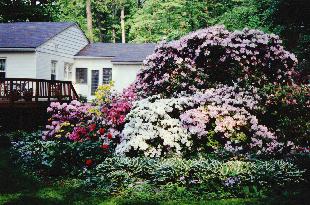 Landscaping is a matter of personal taste. Some people just want a foundation planting while others use landscaping to solve a variety of problems.
Most gardeners are really interested in creating a garden full of flowers. Designs can vary from formal gardens, to naturalistic woodlands, to carefully placed accent plants but one must give special consideration to gardens designed with
trees and flowering shrubs because these plants can get quite large.
The tall rhododendron in the picture to the right is a 30-year old plant
of the Gable hybrid 'Caroline' in the author's own back yard. He has lived
in this home for over 50 years, planting his first garden at the age of 3.
Landscaping is a matter of personal taste. Some people just want a foundation planting while others use landscaping to solve a variety of problems.
Most gardeners are really interested in creating a garden full of flowers. Designs can vary from formal gardens, to naturalistic woodlands, to carefully placed accent plants but one must give special consideration to gardens designed with
trees and flowering shrubs because these plants can get quite large.
The tall rhododendron in the picture to the right is a 30-year old plant
of the Gable hybrid 'Caroline' in the author's own back yard. He has lived
in this home for over 50 years, planting his first garden at the age of 3.
It is always wise to take an inventory of existing items and note any problems that need to be
resolved. Make a list of trees, plant materials, natural features, and structures. Review site exposure, slope, soil type, drainage, sun and shade patterns,
current traffic paths, expected uses, and any animal or wildlife problems. It
is much better to plan ahead than discover mistakes were made many years before.
|
Developing the Design
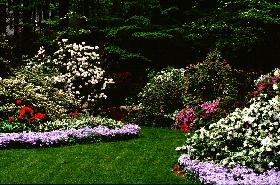 For a rhododendron and azalea garden, plan the
For a rhododendron and azalea garden, plan the
empty space first. With annuals or low growing perennials, one's consideration is with the flower bed, but when plants grow tall such as rhododendrons, it is much better to plan the open area because tall plants will make walls in your garden.
The open spaces will become "garden rooms" so consider traffic flow from
one room to another, either by wide connections or with winding paths.
Once you have defined the open areas, you are free to
plant everything else as flower beds.
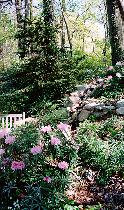 Consider how to treat the various spaces defined in the landscape. Should there be "open spaces" to enhance vistas, "corridors" for transitions between areas, "closed spaces" for privacy, or "extensions" of the home interior? Consider movement between areas and access routes.
Consider how to treat the various spaces defined in the landscape. Should there be "open spaces" to enhance vistas, "corridors" for transitions between areas, "closed spaces" for privacy, or "extensions" of the home interior? Consider movement between areas and access routes.
Design for easy care, avoiding plans that require heavy maintenance or constant pruning. Wide paths are better than narrow walks since the latter often become tunnels over time. If the soil is poorly drained or plants won't grow easily, choose an alternative such as mulched areas or slate. Consider costs, too.
|
Applying the Principles of Art to Landscape Design
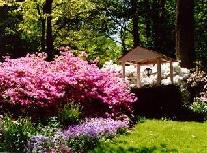 Form and Mass:
Form and Mass:
The mature landscape should be in scale with its surroundings. Plants give the garden form, so mass plantings will be more effective than mixed groupings as gardens age. A planting of 5 to 10 azaleas of the same
variety will look much better than a mixed planting as the garden matures since
the plants will have grown together to look like one large specimen plant.
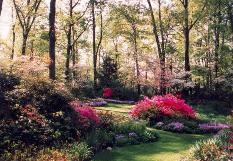 Line:
Line:
Graceful and irregular curves are more interesting than straight lines and sharp angles.
Color and Harmony:
Choose colors and varying leaf textures that go well together. Color schemes should be harmonious and compliment each other and any existing architecture.
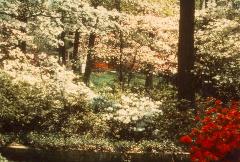
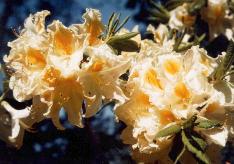 Emphasis and Contrast:
Emphasis and Contrast:
Place light colors against dark ones
for emphasis. Include plenty of white and neutral colors to blend or provide transitions. For gardens with brilliant shrubs like azaleas and rhododendrons,
it is wise to allow for at least 50% of the plants to be white or other
soft tones to allow the eye to have a visual retreat from the more intense
colors. In addition to white, pale pinks and yellows such as those in some
of the Knap Hill azaleas like 'Marina' are good blending colors. The author
also uses soft blue as can be seen in the native wildflower,
Phlox divaricata.
Balance and Repetition:
Informal, asymmetrical balance is preferred to symmetry since formal designs with shrubs become a liability over time. A large planting on one side of the yard can be balanced with a small but similar grouping on the other. Repeat colors and forms.
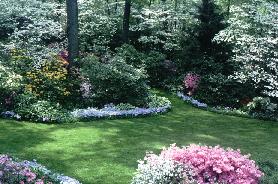
Unity:
Everything should go together. The garden should enhance the home architecture and the community. Simplicity is desirous, but often difficult to achieve for a plant collector.
|
Selecting the Right Rhododendron and Azalea Varieties
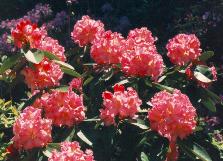 Choose varieties that will grow in scale appropriate for the landscape needs. Some azaleas and rhododendrons can be used as ground covers while others will be trees. Use dwarf varieties in the foreground or constrained places. Use large growers in the background or for screens.
Choose varieties that will grow in scale appropriate for the landscape needs. Some azaleas and rhododendrons can be used as ground covers while others will be trees. Use dwarf varieties in the foreground or constrained places. Use large growers in the background or for screens.
Some varieties are not adapted to our climate, especially rhododendrons developed in cool moist climates that object to our hot humid summers. Varieties developed in the Eastern US are often safer choices in our region. Most evergreen azaleas grow well here.
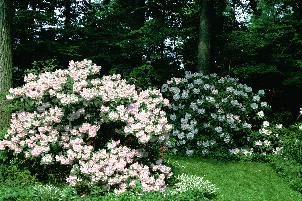 Consider time of bloom. Some varieties flower very early and may need frost protection while others bloom late and might require more shade to extend bloom time. Change the color scheme by selecting plants that bloom at different seasons. Use many companion plants.
Consider time of bloom. Some varieties flower very early and may need frost protection while others bloom late and might require more shade to extend bloom time. Change the color scheme by selecting plants that bloom at different seasons. Use many companion plants.
Some nurseries over fertilize their plants to encourage heavy blooming and quick sales. Such plants are often difficult to establish, even for reliable varieties raised by experience growers.
|
|